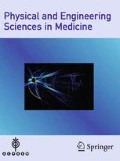Abstract
There are moves to limit by legislation the amount of electric and magnetic fields that workers and the general public are exposed to. In work locations near wiring, cables & equipment carrying high electric currents, there are situations in which the proposed magnetic field limits could be exceeded. Since the limits for the general public are more conservative than those for workers and since the foetus or a pregnant worker should be afforded the status of a member of the general public, it is important to assess a worst-case scenario for the purposes of a general code of practice. Three different magnetic field exposures are modelled, which include the worst case — the body of a pregnant woman at a smallest distance of 30 cm to the conductor. All computations were done by using Multiple Multipole Program (MMP), which is based on the Generalized Multipole Technique (GMT) from ETH (Swiss Federal Institute of Technology), Zurich, Switzerland. In a worst-case scenario the proposed basic restrictions would be exceeded slightly in both maternal and foetal tissue. With appropriate pre-placement assessment, these over-exposures can be avoided.
Similar content being viewed by others
References
Wertheimer, N., Leeper, E.,Electrical wiring configurations and childhood cancer, Amer J Epidemiol. 109, 273–284, 1979.
Stuchly, M. A., Dawson, T.W.,International of low frequency electric and magnetic fields with the human body, Proc. IEEE 88, 643–664, 2000.
ICNIRP. Review of the Epidemiologic Literature on EMF & Health, Environmental Health Perspectives 109, Supp. 6, 2001.
NRPB. Review of the Scientific Evidence for Limiting Exposure to Electromagnetic Fields (0–300 GHz), Available http://www.nrpb.org/publications/documents_of_nrpb/pdfs/do c_15_3.pdf. 15, 2004.
ESAA. Electricity Supply Association of Australia Guideline: Guidelines for live line barehand work, HB ESAA LLM 01–2000, Electricity Supply Association of Australia Ltd, 2000.
ICNIRP. Guidelines for limiting exposure to time-varying electric, magnetic, and electromagnetic fields (up to 300 GHz). International Commission on Non-Ionizing Radiation Protection, Health Phys 74, 494–522, 1998.
IEEE. IEEE Standard for safety levels with respect to human exposure to electromagnetic fields, 0–3 kHz, New York C95.6, 2002.
Gabriel, S., R. W., Lau, R.W., Gabriel, C.,The dielectric properties of biological tissues: II. Measurements in the frequency range 10 Hz to 20 GHz, Phys Med Biol 41, 2251–69, 1996.
Durney, C. H.,Electromagnetic dosimetry for models of humans and animals: a review of theoretical and numerical techniques, Proc. IEEE 68, 33–40, 1980.
10. Hafner, C., Bomholt, L.,The 3D electromagnetic wave Simulator, John Wiley and Sons, Chichester, 1993.
Hafner, C.,Post-modern Electromagnetics: Using intelligent Maxwell solvers, John Wiley and Sons, Chichester, 1999.
Ballisti, R., Hafner, Ch. The multiple multipole method in electro- and magnetostatic problems.IEEE Trans. on magnetics, MAG-19, 2367–2370, 1983.
Kuster, N., Ballisti., R. MMP method simulation of antennae with scattering objects in the closer near field.IEEE Trans. on magnetics, 25, 2881–2883, 1989.
Kiener, S.,Eddy currents in bodies with sharp edges by the MMP-method. IEEE Trans. on magnetics 26, 482–485, 1990.
Kuster, N., Ballisti, R.,Multiple multipole method for simulating EM problems involving biological bodies, IEEE Trans. on biomedical engineering, 40, 611–620, 1993.
Kuster, N., Bomholt, L. H.,A block iterative technique to expand MMP’s applicability to EM problems of higher complexity, IEEE Trans. on microwave theory and techniques 42, 875–883, 1994.
Deno, D. W.,Currents induced in the body by high voltage transmission line electric field — measurement and calculation of distribution and dose, IEEE Trans Power App Syst 96, 1517–1525, 1975.
Martini, F.,Fundamentals of Anatomy and Physiology, Upper Saddle River, NJ. Prentice Hall, 2001.
Author information
Authors and Affiliations
Corresponding author
Rights and permissions
About this article
Cite this article
Xue, C., Wood, A.W. & Dovan, T. Induced current density in the foetus of pregnant workers in high magnetic field environments. Australas Phys Eng Sci Med 27, 199–206 (2004). https://doi.org/10.1007/BF03178649
Received:
Accepted:
Issue Date:
DOI: https://doi.org/10.1007/BF03178649




